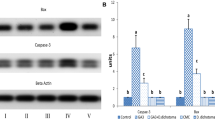Abstract
The influence of the F-55 water-soluble fraction of brown algae extract Fucus vesiculosus on the development of organotypic tissue culture of various origins from three germ layers in young and old rats was studied. The F-55 preparation has a stimulating effect on the processes of cell proliferation in tissues of ecto-, ento- and mesodermal genesis (cerebral cortex, myocardium, spleen, and liver) by regulating the processes of cell proliferation and apoptosis. The revealed strengthening of regeneration processes in explants from both young and old rats under the influence of the F-55 preparation in ultra-low concentrations of 10–100 ng/mL can be used to produce new, medicinal, cytoprotective substances that allow the enhancement of cell regeneration in various tissues under pathological conditions, including those associated with age.
Similar content being viewed by others
REFERENCES
Biokhtarova, N.I., Fomina, N.N., Rykova, V.A., et al., Antitumor effect of ultra-low doses of doxorubicin in experimental conditions, Byull. Eksp. Biol. Med., 2003, vol. 135, no. 1, pp. 48–49.
Zakutskii, A.N., Chalisova, N.I., Ryzhak, G.A., et al., Tissue-specific effect of synthetic bioregulatory peptides in organotypic tissue culture of young and old rats, Usp. Gerontol., 2006, vol. 19, no. 1, pp. 93–96.
Terekhova, S.F. and Grechenko, T.N., Regulation of the functional state of the neuron by ultra-low doses of various biologically active substances, Radiats. Biol., Radioekol., 2003, vol. 43, no. 3, pp. 315–319.
Trofimova, S.V., Linkova, N.S., Klimenko, A.A., et al., Pineamin increased pineal melatonin synthesis in elderly people, Adv. Gerontol., 2017, vol. 7, no. 4, pp. 319–322.
Khavinson, V.K., Sevostyanova, N.N., Durnova, A.O., et al., Tetrapeptide stimulates functional activity of pancreatic cells in aging, Adv. Gerontol., 2013, vol. 3, no. 3, pp. 220–224.
Chalisova, N.I., Knyaz’kin, I.V., and Kvetnoi, I.M., Neiroendokrinnye mekhanizmy deistviya peptidov i aminokislot v tkanevykh kul’turakh (Neuroendocrine Activity of Paptides and Amino Acids in Tissue Cultures), St. Petersburg: DEAN, 2005.
Chalisova, N.I., Penniyainen, V.A., and Nozdrachev, A.D., The stimulatory effect of small doses of inhibitors in organotypic culture of nervous and lymphoid tissues, Dokl. Biol. Sci., 2002, vol. 383, nos. 1–6, pp. 96–98.
Baerwolff, M. and Bie, P., Effects of subpicomolar changes in vasopressin on urinary concentration, Am. J. Physiol., 1988, vol. 255, no. 2, pp. R940–R945.
Chen, N., Li, Q., Liu, J., and Jia, S., Irisin, an exercise-induced myokine as a metabolic regulator: an updated narrative review, Diabetes Metab. Res. Rev., 2016, vol. 32, no. 1, pp. 51–59.
Dreos, R., Ambrosini, G., Cavin, P., et al., EPD and EPDnew, high-quality promoter resources in the next generation sequencing era, Nucleic Acids Res., 2013, vol. 41, pp. 157–164.
Ferreres, F., Lopes, G., Gil-Izquierdo, A., et al., Phlorotannin extracts from fucales characterized by HPLC-DAD-ESI-MSn: approaches to hyaluronidase inhibitory capacity and antioxidant properties, Mar. Drugs, 2012, vol. 10, no. 12, pp. 2766–2781.
Khavinson, V., Linkova, N., Kukanova, E., et al., Neuroprotective effect of EDR peptide in mouse model of Huntington’s disease, J. Neurol. Neurosci., 2017, vol. 8, no. 1, pp. 1–11.
Lickert, H., Betatrophin fuels β cell proliferation: first step toward regenerative therapy?, Cell Metab., 2013, vol. 18, no. 1, pp. 5–6.
Toledo, F.G. and Wahl, M., Regulating the p53 pathway: in vitro hypotheses, in vivo veritas, Nat. Rev. Cancer, 2006, vol. 6, pp. 909–923.
Aubrey, B.G., Kelly, G.L., Janic, A., et al., How does p53 induce apoptosis and how does this relate to p53-mediated tumour suppression?, Cell Death Differ., 2018, vol. 25, pp. 104–113.
Author information
Authors and Affiliations
Corresponding authors
Ethics declarations
Conflict of interest. The authors declare that they have no conflict of interest.
Statement on animal welfare. All applicable international, national, and institutional guidelines for the care and use of animals were followed.
Additional information
Translated by I. Matiulko
Rights and permissions
About this article
Cite this article
Chalisova, N.I., Rizhak, G.A., Zayitseva, M.A. et al. Stimulating Effect of the Water-Soluble Fraction from Brown Algae Fucus vesiculosus Extract on Cell Proliferation in the Tissue Culture of Young and Old Rats. Adv Gerontol 10, 282–286 (2020). https://doi.org/10.1134/S2079057020030054
Received:
Revised:
Accepted:
Published:
Issue Date:
DOI: https://doi.org/10.1134/S2079057020030054




